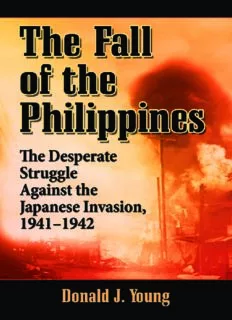
The Fall of the Philippines: The Desperate Struggle Against the Japanese Invasion, 1941-1942 PDF
Preview The Fall of the Philippines: The Desperate Struggle Against the Japanese Invasion, 1941-1942
The Fall of the Philippines ALSOBYDONALDJ. YOUNG Final Hours in the Pacific: The Allied Surrenders of Wake Island, Bataan, Corregidor, Hong Kong and Singapore(2011) The Battle of Bataan: A Complete History, 2d ed.(2009) The Fall of the Philippines The Desperate Struggle Against the Japanese Invasion, 1941–1942 Donald J. Young McFarland & Company, Inc., Publishers Jefferson, North Carolina LIBRARYOFCONGRESSCATALOGUING-IN-PUBLICATIONDATA Young, Donald J., 1930– The fall of the Philippines : the desperate struggle against the Japa- nese invasion, 1941/1942 / Donald J. Young. p. cm. Includes bibliographical references and index. ISBN 978-0-7864-9820-8 (softcover : acid free paper) ♾ ISBN 978-1-4766-2047-3 (ebook) 1. Bataan, Battle of, Philippines, 1942. 2. World War, 1939–1945—Campaigns—Philippines. I. Title. D767.4.Y693 2015 940.54'2599—dc23 2015006191 BRITISHLIBRARYCATALOGUINGDATAAREAVAILABLE © 2015 Donald J. Young. All rights reserved No part of this book may be reproduced or transmitted in any form or by any means, electronic or mechanical, including photocopying or recording, or by any information storage and retrieval system, without permission in writing from the publisher. Cover image: Japanese air raid in Barrio, Paranque, in the Philippine Islands, December 13, 1941, U.S. Army Corps Image (Library of Congress) Printed in the United States of America McFarland & Company, Inc., Publishers Box 611, Jefferson, North Carolina 28640 www.mcfarlandpub.com Table of Contents Introduction 1 1. “Never even got into the air” 3 2. The Philippines, December 10, 1941: “Where are our fighters?” 14 3. Moon Under Lingayen 30 4. When America Needed Heroes: Wheless and Wagner, December 10–16 38 5. The USS Canopus 48 6. A Scary Christmas But a Happy New Year: The Philippines, December 1941 58 7. The Last and the First: Bataan, January 18, 1942 65 8. The First Battle for Bataan: January 18, 1942 75 9. “Think what we could have done with sixty!” 84 10. Biggest Day for the Bataan Air Force: March 3, 1942 91 11. Japanese Blitzkrieg: April 3, 1942 98 12. The Deliberate Bombing of Bataan Hospital No. 1 107 13. The Fighting General of Bataan 119 14. Honorable But Not Easy: The Surrender of Bataan 133 v Table of Contents 15. “P-40 Something”: The Last of the Tomahawks 146 16. Corregidor Fights Back: May 6, 1942 154 17. “You will, repeat, will surrender” 191 Chapter Notes 203 Bibliography 207 Index 209 vi Introduction Along with Pearl Harbor and Wake Island, World War II began for the United States with the s ame-d ay Japanese attack on the Philippine Islands. Unlike Pearl Harbor and the quick capture of Wake Island on December 25, 1941, war in the distant Philippines would not officially end until June 1942, seven months later. During those seven months, the Philippines remained virtually cut off from the friendly outside world, as did interest in its end when over- shadowed by the miracle U.S. victory at Midway that same June. Even to this day, the battle and fall of the Philippines has never attracted interest like other events of the war. Along with its loss went experiences and history of the battle that, compared to those covered in the two and a half years of war to come, have still never been told. While there are many stories lost or unwritten, because of the rapid fall of the distant and isolated islands, I have chosen to write about the 17 I feel best represent that bitter and oft forgotten campaign. 1 This page intentionally left blank 1 “Never even got into the air” In the 1943 Hollywood movie Air Force, a gruff B-17 crew chief, played by actor Harry Carey, when told that his fighter pilot son’s plane had taken a direct hit while attempting to take off from Clark Field on December 8, commented, “Never even got into the air.” Little did the producer of the movie know just how similar that scenario was to what actually happened at Clark Field that day. Results of the Japanese attacks on U.S. fighter forces in the Philip- pines on December 8, 1941, amounted to the staggering loss of 35 of the 86 frontline P-40 fighters in the islands. Of that number, nothing was more tragic or devastating than the loss of fifteen of the 20th Pursuit Squadron’s eighteen P-40s within the first minutes of the attack on Clark Field. This is the story of those that never did get into the air. The story of that fateful moment actually began a little after mid- night on December 8, when the only functioning radar on Luzon, located at the northern edge of Iba Field, site of one of the four U.S. fighter bases in the islands, picked up a flight of Japanese planes 115 miles northwest of the field. Based on their line of approach, their assumed target was Manila. When the news reached 27-year-old 1st Lt. Joe Moore, commander of the 20th Pursuit Squadron at Clark Field, he ordered his entire squadron from their quarters at nearby Fort Stotsenburg to the 24th Pursuit Group operations hanger at the edge of the field. There they were met by group commander Major Orrin Grover who, after explaining why they had been called out, ordered all t hirty- six 20th pilots to remain near their planes until further notice. Two 3
Description: